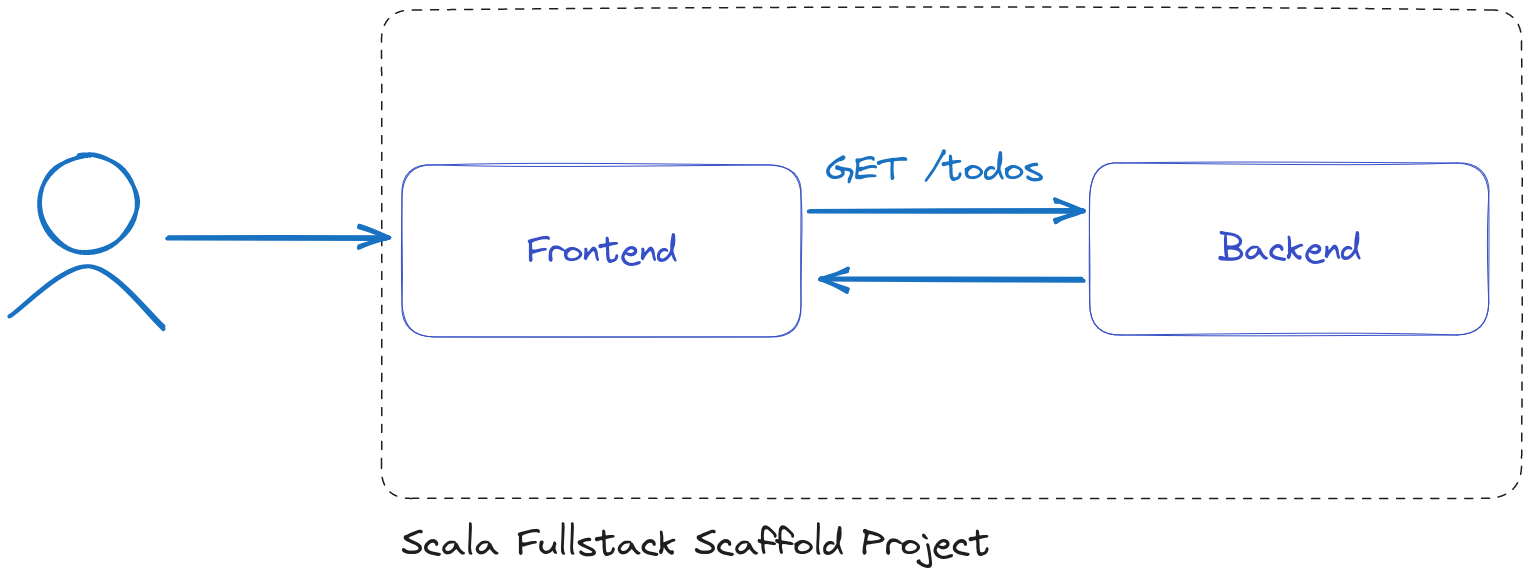About
This page references how is build this project and which Library are used.
Architecture
Here's a high-level overview of the architecture:
Front-end:
User Interface (UI): The front-end component handles the presentation layer of the application and provides an interface for users to interact with the TODO application.
ScalaJS
The frontend application is build using ScalaJS.
Scala.js (opens in a new tab) is a powerful framework that harnesses the Scala and JavaScript ecosystems,
enabling the development of robust applications for browsers, Node.js (opens in a new tab), and serverless environments.
With its strong typing, Scala.js ensures code correctness, eliminating common mistakes such as mixing
data types and typos in method names. It optimizes Scala code into highly efficient JavaScript,
offering fast compilation times and generating compact output starting from 45kB gzipped.
Scala.js seamlessly integrates with popular JavaScript libraries like React and AngularJS, providing excellent interoperability. The framework also offers exceptional editor support, catching typos and type-errors instantly, providing in-line documentation, and facilitating effortless refactoring. Unlock the potential of Scala and JavaScript with Scala.js for building performant applications with a seamless development experience.
Backend:
Application Server: The back-end component handles the business logic and data management of the application. It receives requests from the front-end, processes them, interacts with the database, and returns the appropriate response.
API (Application Programming Interface): The back-end exposes a set of RESTful or GraphQL APIs that the front-end can consume to perform CRUD (Create, Read, Update, Delete) operations on TODO items. The APIs handle the data validation, authentication, and authorization aspects of the application. Database: A persistent storage system is needed to store the TODO items. Common choices include relational databases like MySQL, PostgreSQL, or non-relational databases like MongoDB.
ZIO is used for the REST API.
ZIO
ZIO (opens in a new tab) is a powerful library for Scala that provides type-safe, composable, and concurrent programming capabilities.
With ZIO, you can easily build scalable applications that outperform Scala's Future by a factor of 100.
By leveraging the full power of the Scala compiler, ZIO enables you to catch bugs at compile time, ensuring type safety and robustness in your codebase. ZIO simplifies the development of concurrent applications, eliminating common issues like deadlocks, race conditions, and complexity.
It allows you to write sequential code that remains consistent, whether it's executed asynchronously or synchronously. Additionally, ZIO promotes resource-safe practices, preventing resource leaks even in the face of failures.
It offers excellent testability, allowing you to inject test services into your application for fast, deterministic, and type-safe testing. ZIO empowers you to build resilient applications that handle errors gracefully and respond to failures locally and flexibly.
With its functional programming approach, ZIO enables rapid composition of solutions to complex problems using simple building blocks.
Architecture

This architecture provides a basic structure for a TODO Fullstack application, but keep in mind that specific implementation details and technologies may vary based on individual preferences, project requirements, and scalability considerations.
The architecture consists of a frontend application and a backend built with ZIO and Scala.js. The frontend application provides a user interface for managing TODOs, while the backend exposes an API to interact with the TODOs data.
The frontend application, developed with Scala.js, benefits from the seamless integration with ZIO, enabling the use of reactive components and ensuring high-performance.
Authors
This project was written by the following:
How to start ?
You can start to play with this project with the Quick start.